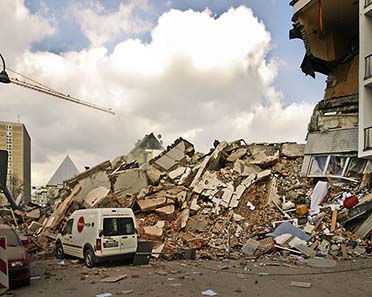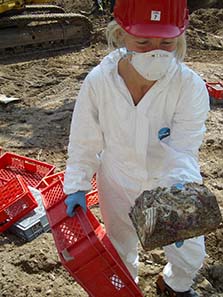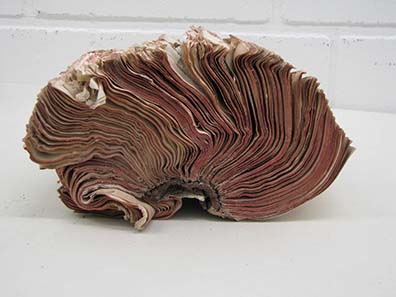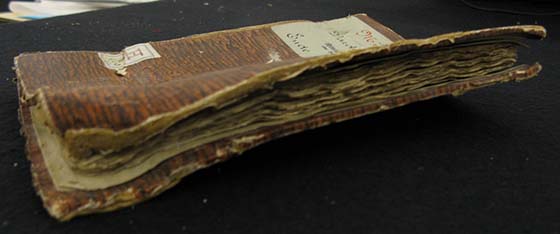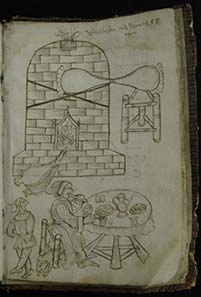Appeal for money to save numismatically valuable manuscripts
May 20th, 2010 – Who could forget the horrible pictures when on March 3rd, 2009, the Cologne City Archive collapsed. It was the biggest municipal archive north of the Alps containing roughly 65.000 valuable records and documents – from as early as 922 until the present day. 27 kilometres of shelve of file boxes then lay in ashes.
The Cologne City Archive shortly after the collapse. Photograph: Frank Domahs / Wikipedia.
The precious archive materials were hit by parts of the building that came crashing down; they were gummed up by concrete dust and soaked by extinguishing water – in short, nobody would have thought that anything could be saved at all.
Hundreds of archivists from all over the world came to Cologne voluntarily to provide assistance in the recovery of the manuscripts.
Today, one year later, we know that 85% of the archive materials were rescued after all. Of course, in their present state they are not usable. At the moment, they are awaiting their restoration. It will take decades to do so, several hundreds of millions of Euros will be necessary to restore the materials before scientists will have access to that heritage of mankind again.
Cologne‘s numismatic collections
To numismatics, the Cologne Archive is of paramount importance. Numerous Medieval and early Modern Münzwardein books are stored there that record, amongst other things, the respective circulating coins plus their accorded value. That is important not only for Cologne but for the surroundings as well since the Cologne Münzwardeine from the 16th century onwards also held functions for the Lower Rhenish-Westphalian Circle.
Not just the trade made a supervision of coins necessary but also the writtenness of the administration and legal transactions of the citizens which Cologne, compared to other cities, developed quite early, i.e. in the 12th century. Wherever buying prices of property, interests or annuities were recorded in written form and thus elevated from the level of business transacted between two people, the question of the calculation of the stated sums of money was of public interest, in case of a possible lawsuit where the registration may have served as evidence.
It is no surprise, therefore, that the Historical Archive’s old inventories include numerous numismatic sources of high degree. Inventory “90” (trade) alone contains more than 100 files and office books from the late Middle Ages and early Modern times devoted to coinage. In total, that inventory spans more than 40 metres of shelve providing detailed insight into international monetary transactions of those times as well as the inventories of the Hanseatic League (inventories 80 to 84) containing quite a number of sources of the European long-distance trade. Inventory 14 (edicts) contains numerous decrees on coinage. There is no point in continuing that list because further references would concern almost the entire older archive material – after all, topics like money, translation of currency and coinage is important in every sphere in various degrees.
Bizarrely deformed book from the 15th century.
Like almost every other inventory, the numismatic sources were strongly affected by the collapse of the Historical Archive of the city of Cologne on March 3rd, 2009. Indeed, 85% of the archive material was rescued but most of it is heavily damaged and hence not accessible in its original state for years and decades to come. Apart from mechanic damage like deformation, shredding or tearing, damage by water and, as a result, by mould occurred – even where the damage is seemingly minor, the entire archive material is covered by a fine concrete dust that has to be removed sheet by sheet. That takes decades and several hundreds of millions of Euros.
| Coin collectors as the true custodians of cultural assets! Hundreds of numismatic and economic historical sources are stored in Cologne which surely are not at the top of the priority list for a restoration funding. Therefore, the disappearing of a history coin collectors are interested in is imminent. Research is hindered by the gigantic damage that makes an accession of the Cologne sources impossible for decades. The coin collectors are now facing a possibility to make clear who is really interested in protecting cultural assets! The Cologne disaster is a chance for every responsible coin collector to show that not only our own collection but the public treasures as well are near and dear to us! Just now, in the ongoing discussion about cultural assets, emphatic and generous help is of the essence! After all, we collectors are willing to assume responsibility for our common past! |
A Cologne Münzwardein book – price of restoration: 2.500 Euros
Big things can be achieved when many are working together. To give but one example: only 2.500 Euros are needed to save a precious testimony of the early history of coinage.
The remains of a Cologne Münzwardein book from the 15th century.
It is a Cologne Münzwardein book from the 15th century that needs moderate restoration (Inv. 90, no. 959). In the middle of the 15th century, the council of the city of Cologne obtained advisory opinions about the value of the Mark silver and the shillings that included different views on current and past customs. Similar problems occurred in regard to other species and of course foreign money of all kinds. That uncertainty about the value, resulting in a threat to trade and legal certainty, exchange rates and money denominations provide the background of the present Münzwardein book from the late 15th century although earlier efforts to arrange the local coinage as well are attested.
The book is a functional script on paper not aiming at prestigious design but at being handy. That is precisely its historical value since the book provides an actual insight into the problems and methods of an official whose daily business was to control and supervise coins of all sorts.
Picture of a melting furnace, in front of it a table with the dining master and his apprentice.
Consequently, the book contains numerous pages on the different species, specifications of metal contents, token coins and exterior features. Production techniques and tools are described, too. Some pen and ink drawings are included as well, like the ones depicting the furnaces used. One page 53 a melting furnace is shown. In the foreground, a master is dining on a table with an apprentice standing beside him. As a result of the collapse, the book cover is markedly deformed. Binding spine and both paperboard covers are broken several times. The covering paper has bad spots and numerous fissures. Due to the deformation the book’s mechanics of the cover, i.e. when opened and closed, are impaired. The sewing is broken in some areas, and the innerbook is slightly deformed. The sheets’ edges have bad spots, fissures and kinks. The innerbook contains small stones, dirt and sand.
The restoration of these, compared to other archive material, only moderate damages requires roughly 2.500 Euros. Cleansing, smoothing, closure of fissures and new binding require laborious handwork.
Everyone can help!
Please help to save the present source plus many more and donate money to cover the expenses. Dr Max Plassmann of the Historical Archive Cologne has assured us that every object whose restoration is funded by coin collectors will carry the additional remark „Restauriert mit Hilfe von Mitteln aus der Aktion „Münzensammler für Köln“.
| Donation account:
Account holder: Freunde des Historischen Archivs der Stadt Köln e.V. It is of vital importance to fill in the reference with “Patenschaft Münzwardeinbuch” to make sure that your donation will be used for a specific purpose. Anyone who would like to make a larger donation to save “his own” document is kindly asked to visit the website www.historischesarchivkoeln.de for more information on restoration sponsorships. There, the Historical Archive Cologne presents single objects it would like to restore with the help of sponsors. You may also approach the contact persons of the Historical Archive Cologne directly. Dr Max Plassmann: phone: +49 221/221-22330 |





